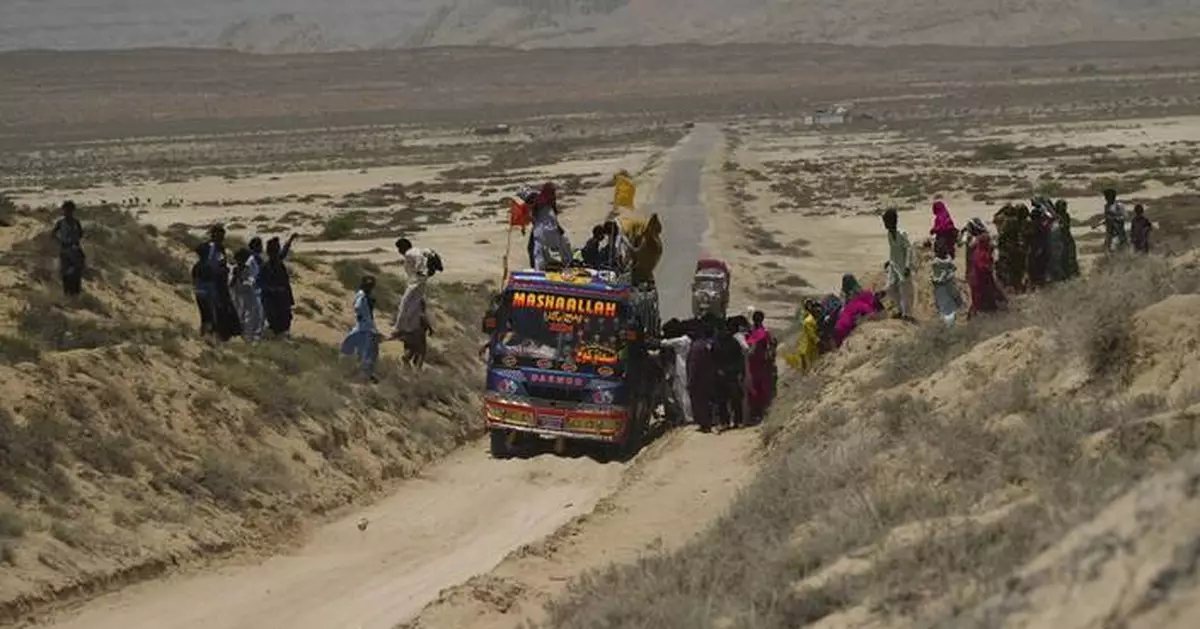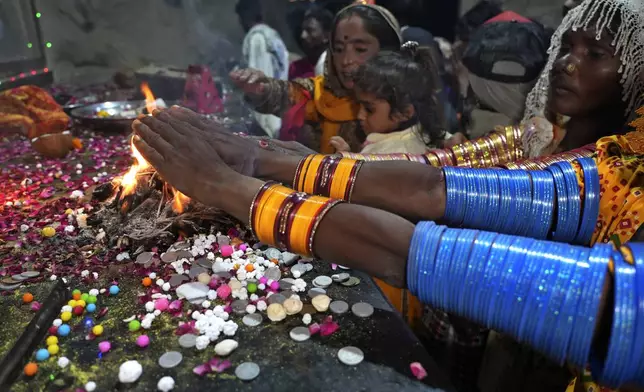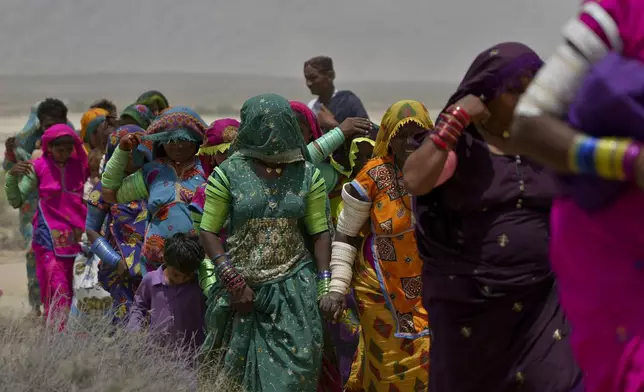HINGLAJ, Pakistan (AP) — The ascent of steep mud volcanoes marks the start of Hindu pilgrims’ religious rituals in southwestern Pakistan.
They climb hundreds of stairs or clamber over rocks to reach the summit, tossing coconuts and rose petals into the shallow crater while seeking divine permission to visit Hinglaj Mata, an ancient cave temple that is the focus of their three-day worship.
Click to Gallery
HINGLAJ, Pakistan (AP) — The ascent of steep mud volcanoes marks the start of Hindu pilgrims’ religious rituals in southwestern Pakistan.
In this aerial photo taken from a drone, Hindu devotees climb stairs to reach on top of a mud volcano to start Hindu pilgrims religious' rituals for an annual festival in an ancient cave temple of Hinglaj Mata in Hinglaj in Lasbela district in Pakistan's southwestern Baluchistan province, Friday, April 26, 2024. More than 100,000 Hindus are expected to climb mud volcanoes and steep rocks in southwestern Pakistan as part of a three-day pilgrimage to one of the faith's holiest sites. (AP Photo/Mohammad Farooq)
Hindu devotees attend an annual festival in an ancient cave temple of Hinglaj Mata in Hinglaj in Lasbela district in Pakistan's southwestern Baluchistan province, Friday, April 26, 2024. More than 100,000 Hindus are expected to climb mud volcanoes and steep rocks in southwestern Pakistan as part of a three-day pilgrimage to one of the faith's holiest sites. (AP Photo/Junaid Ahmed)
Hindu devotees attend an annual festival in an ancient cave temple of Hinglaj Mata in Hinglaj in Lasbela district in the Pakistan's southwestern Baluchistan province, Friday, April 26, 2024. More than 100,000 Hindus are expected to climb mud volcanoes and steep rocks in southwestern Pakistan as part of a three-day pilgrimage to one of the faith's holiest sites. (AP Photo/Junaid Ahmed)
Hindu devotees dance during an annual festival in an cave temple of Hinglaj Mata in Hinglaj in Lasbela district in Pakistan's southwestern Baluchistan province, Friday, April 26, 2024. More than 100,000 Hindus are expected to climb mud volcanoes and steep rocks in southwestern Pakistan as part of a three-day pilgrimage to one of the faith's holiest sites. (AP Photo/Junaid Ahmed)
Hindu devotees perform their rituals during an annual festival in an ancient cave temple of Hinglaj Mata in Hinglaj in Lasbela district in Pakistan's southwestern Baluchistan province, Friday, April 26, 2024. More than 100,000 Hindus are expected to climb mud volcanoes and steep rocks in southwestern Pakistan as part of a three-day pilgrimage to one of the faith's holiest sites. (AP Photo/Junaid Ahmed)
Hindu devotees perform their rituals during an annual festival in an ancient cave temple of Hinglaj Mata in Hinglaj in Lasbela district in Pakistan's southwestern Baluchistan province, Friday, April 26, 2024. More than 100,000 Hindus are expected to climb mud volcanoes and steep rocks in southwestern Pakistan as part of a three-day pilgrimage to one of the faith's holiest sites. (AP Photo/Junaid Ahmed)
Hindu devotees arrive at an ancient cave temple of Hinglaj Mata to attend an annual festival in Hinglaj in Lasbela district in Pakistan's southwestern Baluchistan province, Friday, April 26, 2024. More than 100,000 Hindus are expected to climb mud volcanoes and steep rocks in southwestern Pakistan as part of a three-day pilgrimage to one of the faith's holiest sites. (AP Photo/Junaid Ahmed)
Hindu devotees arrive at an ancient cave temple of Hinglaj Mata to attend an annual festival in Hinglaj in Lasbela district in Pakistan's southwestern Baluchistan province, Friday, April 26, 2024. More than 100,000 Hindus are expected to climb mud volcanoes and steep rocks in southwestern Pakistan as part of a three-day pilgrimage to one of the faith's holiest sites. (AP Photo/Junaid Ahmed)
Hindu devotees climb stairs to reach atop an ancient cave temple of Hinglaj Mata to attend an annual festival in Hinglaj in Lasbela district in the Pakistan's southwestern Baluchistan province, Friday, April 26, 2024. More than 100,000 Hindus are expected to climb mud volcanoes and steep rocks in southwestern Pakistan as part of a three-day pilgrimage to one of the faith's holiest sites. (AP Photo/Junaid Ahmed)
Hindu devotees take rest upon arrival at an ancient cave temple of Hinglaj Mata to attend an annual festival in Hinglaj in Lasbela district in the Pakistan's southwestern Baluchistan province, Friday, April 26, 2024. More than 100,000 Hindus are expected to climb mud volcanoes and steep rocks in southwestern Pakistan as part of a three-day pilgrimage to one of the faith's holiest sites. (AP Photo/Junaid Ahmed)
Hindu devotees walk toward a mud volcano, to start Hindu pilgrims' religious rituals for an annual festival in an ancient cave temple of Hinglaj Mata in Hinglaj in Lasbela district in the Pakistan's southwestern Baluchistan province, Friday, April 26, 2024. More than 100,000 Hindus are expected to climb mud volcanoes and steep rocks in southwestern Pakistan as part of a three-day pilgrimage to one of the faith's holiest sites. (AP Photo/Junaid Ahmed)
Hindu devotees perform their rituals on a mud volcano to start Hindu pilgrims' religious rituals for an annual festival in an ancient cave temple of Hinglaj Mata in Hinglaj in Lasbela district in the Pakistan's southwestern Baluchistan province, Friday, April 26, 2024. More than 100,000 Hindus are expected to climb mud volcanoes and steep rocks in southwestern Pakistan as part of a three-day pilgrimage to one of the faith's holiest sites. (AP Photo/Junaid Ahmed)
Hindu devotees climb stairs to reach atop a volcano to start Hindu pilgrims' religious rituals for an annual festival in an ancient cave temple of Hinglaj Mata in Hinglaj in Lasbela district in Pakistan's southwestern Baluchistan province, Friday, April 26, 2024. More than 100,000 Hindus are expected to climb mud volcanoes and steep rocks in southwestern Pakistan as part of a three-day pilgrimage to one of the faith's holiest sites. (AP Photo/Junaid Ahmed)
Hindu devotees walk toward a mud volcano to start Hindu pilgrims' religious rituals for an annual festival in an ancient cave temple of Hinglaj Mata in Hinglaj in Lasbela district in the Pakistan's southwestern Baluchistan province, Friday, April 26, 2024. More than 100,000 Hindus are expected to climb mud volcanoes and steep rocks in southwestern Pakistan as part of a three-day pilgrimage to one of the faith's holiest sites. (AP Photo/Junaid Ahmed)
Hindu devotees walk toward a mud volcano to start Hindu pilgrims' religious rituals for an annual festival in an ancient cave temple of Hinglaj Mata in Hinglaj in Lasbela district in the Pakistan's southwestern Baluchistan province, Friday, April 26, 2024. More than 100,000 Hindus are expected to climb mud volcanoes and steep rocks in southwestern Pakistan as part of a three-day pilgrimage to one of the faith's holiest sites. (AP Photo/Junaid Ahmed)
Hindu devotees walk toward a mud volcano to start Hindu pilgrims' religious rituals for an annual festival in an ancient cave temple of Hinglaj Mata in Hinglaj in Lasbela district in the Pakistan's southwestern Baluchistan province, Friday, April 26, 2024. More than 100,000 Hindus are expected to climb mud volcanoes and steep rocks in southwestern Pakistan as part of a three-day pilgrimage to one of the faith's holiest sites. (AP Photo/Junaid Ahmed)
Hindu devotees get off from a bus and walk toward a mud volcano, to start Hindu pilgrims religious rituals for an annual festival in an ancient cave temple of Hinglaj Mata in Hinglaj in Lasbela district in the Pakistan's southwestern Baluchistan province, Friday, April 26, 2024. More than 100,000 Hindus are expected to climb mud volcanoes and steep rocks in southwestern Pakistan as part of a three-day pilgrimage to one of the faith's holiest sites. (AP Photo/Junaid Ahmed)
The dramatic surroundings of Hingol National Park in Baluchistan province are the setting for Pakistan’s largest Hindu festival, Hinglaj Yatra, which started on Friday and ends on Sunday. Organizers say more than 100,000 Hindus are expected to participate.
Muslim-majority Pakistan is home to 4.4 million Hindus, just 2.14% of the population, and Hinglaj Mata is one of the few Hindu sites that continues to draw large numbers of pilgrims every year from across the country.
Muslims and Hindus generally live peacefully in Pakistan, from where most of the Hindus migrated to India when it was divided by British colonialists in 1947. But there have been attacks on Hindu temples in recent years as relations between the rivals remain tense.
Hindus believe Hinglaj Mata is one the places where the remains of Sati, the goddess of marital felicity and longevity, fell to earth after she ended her life.
Maharaj Gopal, the temple’s most senior cleric, explains why people flock to it.
“It is the most sacred pilgrimage in the Hindu religion,” said Gopal. “Whoever visits the temple and worships accordingly during these three days will have all of their sins forgiven.”
The journeys begin hundreds of kilometres (miles) away, mostly from neighbouring Sindh province. Hundreds of packed buses set off from cities like Hyderabad and Karachi, traveling along the Makran Coastal Highway that hugs Pakistan’s south and southwest.
But there’s scant parking and vehicular access to the holy sites, so many pilgrims disembark and complete their travel by walking over parched and rocky terrain, sometimes barefoot and carrying children or luggage.
It’s a few kilometres (miles) from the main road to the mud volcano and then, from there, almost 45 kilometres (25 miles) to Hinglaj Mata.
Winds buffet the desert-like conditions, churning up dust that whips the eyes, nose and mouth. The pilgrims’ festive cheer and brightly coloured apparel are a contrast to the arid landscape. Strong gusts distort people’s celebratory cries of “Jai mata di” and “Jai shiv shankar.”
Kanwal Kumar, 28, was visiting the temple for the first time with her husband. “We have yet to conceive a child after six years of marriage, so we are hopeful for help from the goddess,” she said. “We believe that no one returns empty-handed. All wishes are granted by Hinglaj Mata.”
The Hindu festival brings the Pakistani park to life. Hundreds of stalls spring up to sell snacks, drinks, jewellery, and clothing. Vats of hot food are prepared in the open air or thatched huts. Pilgrims purchase coconuts, sweetmeats, flowers, and incense for their ritualistic offerings.
Aloo Kumar, 55, wanted to express her gratitude to Lord Shiva, one of Hinduism’s three most important deities. “He blessed our family with a grandson,” Kumar said, gesturing toward the boy beside her cradling his baby sibling. “We prayed for a grandson during last year’s festival.”
Hinglaj Mata thrums with activity, even after dark. Fairy lights and other decorations adorn the shrine and pilgrims jostle for position in front of it, sometimes holding up babies so the deities can bless them. Stewards urge them to pay their respects and move along.
The park’s Hingol River provides Hindu pilgrims with the opportunity for ritual bathing, like the Ganges in India.
While there is no ban on Hindu worship in Pakistan, openly practising the faith is not routine as ties between India and Pakistan are broken. Their interactions are riddled with animosity and suspicion after having fought three wars, built up their armies and armed them with nuclear weapons.
Travel restrictions and hostile bureaucracies largely keep people from crossing the border for leisure, study and work, although the countries sometimes make exceptions for religious pilgrimages, usually for India’s Sikhs.
The decades of political hostility present a challenge for the minority Hindu community, as many in Pakistan equate Hindus with India. The reverse exists in India, where Muslims complain of discrimination.
Versimal Divani, the general-secretary of Hinglaj Mata, lamented that only Hindus in Pakistan can attend the festival.
“We can visit this temple in our beloved country whenever our heart desires,” said Divani. “But this is not the case for the rest of the world’s Hindus. I would like the Pakistani government to issue them visas so they can come here and take blessings with them. It’s good for people-to-people contact and it’s good for the economy too.”
Associated Press religion coverage receives support through the AP’s collaboration with The Conversation US, with funding from Lilly Endowment Inc. The AP is solely responsible for this content.
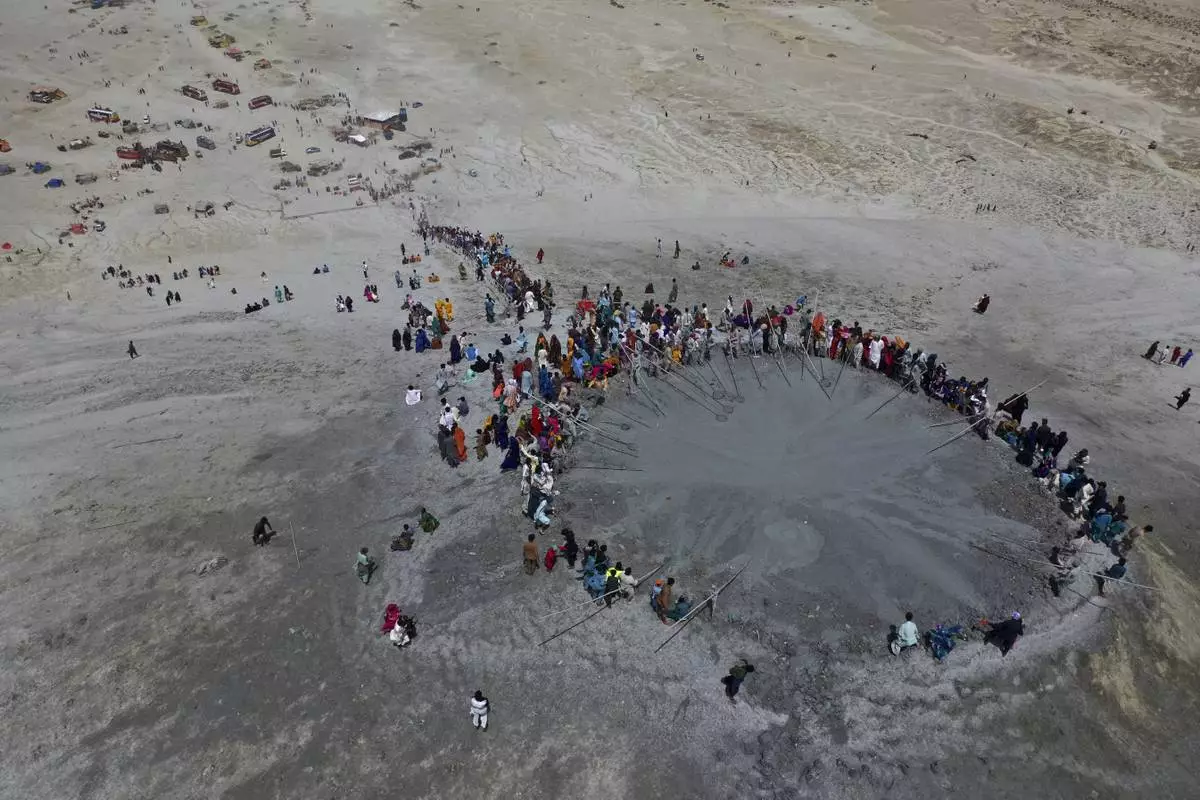
In this aerial photo taken from a drone, Hindu devotees climb stairs to reach on top of a mud volcano to start Hindu pilgrims religious' rituals for an annual festival in an ancient cave temple of Hinglaj Mata in Hinglaj in Lasbela district in Pakistan's southwestern Baluchistan province, Friday, April 26, 2024. More than 100,000 Hindus are expected to climb mud volcanoes and steep rocks in southwestern Pakistan as part of a three-day pilgrimage to one of the faith's holiest sites. (AP Photo/Mohammad Farooq)
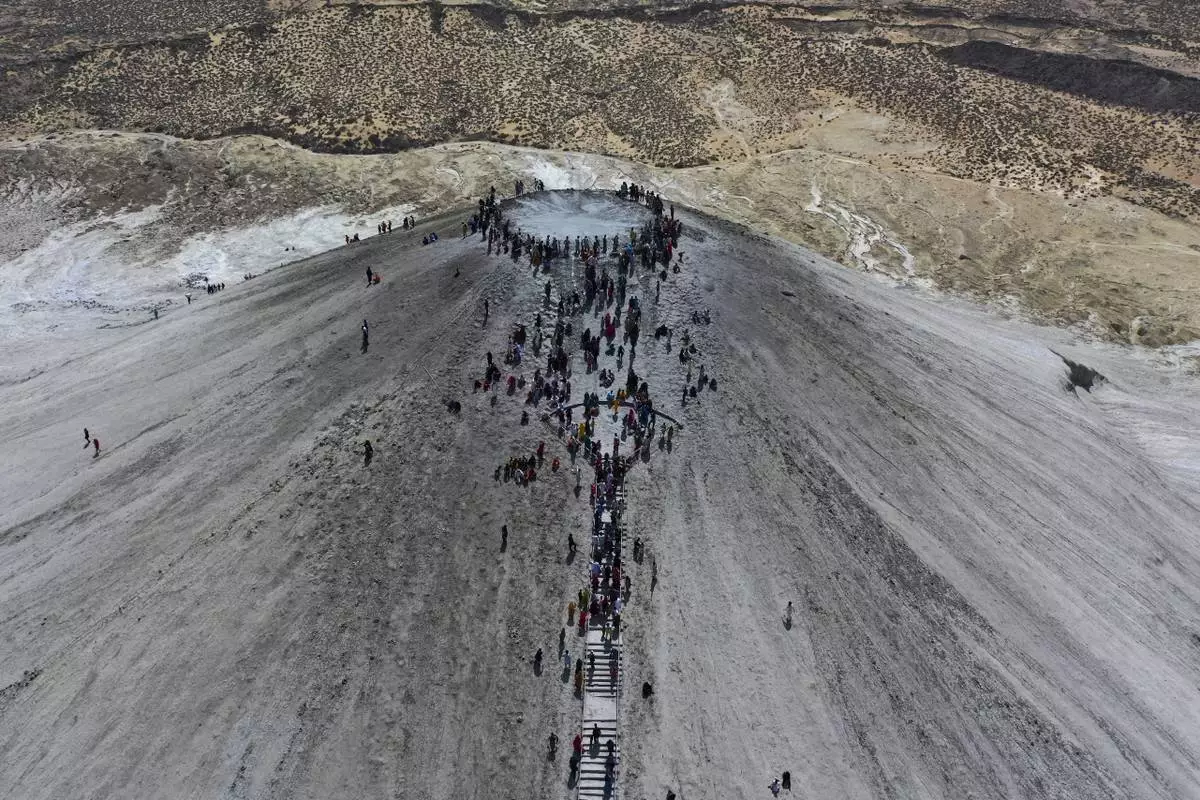
In this aerial photo taken from a drone, Hindu devotees climb stairs to reach on top of a mud volcano to start Hindu pilgrims religious' rituals for an annual festival in an ancient cave temple of Hinglaj Mata in Hinglaj in Lasbela district in Pakistan's southwestern Baluchistan province, Friday, April 26, 2024. More than 100,000 Hindus are expected to climb mud volcanoes and steep rocks in southwestern Pakistan as part of a three-day pilgrimage to one of the faith's holiest sites. (AP Photo/Mohammad Farooq)
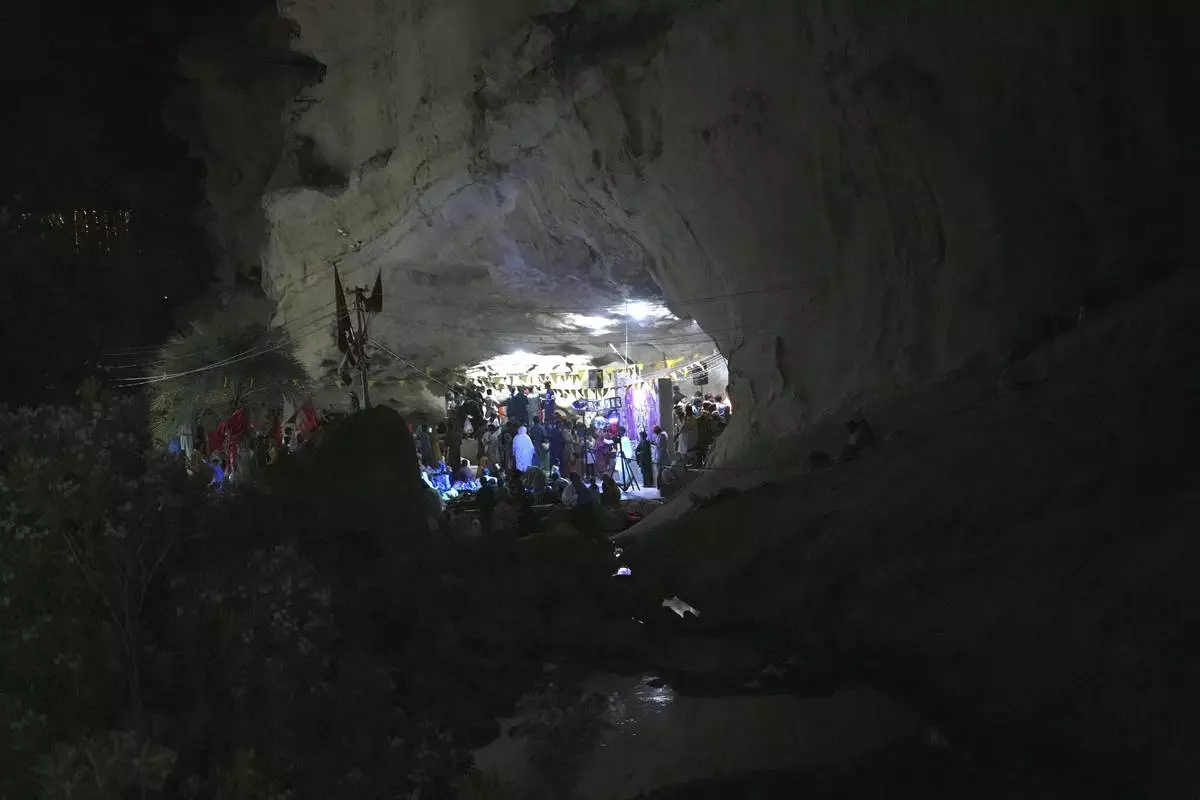
Hindu devotees attend an annual festival in an ancient cave temple of Hinglaj Mata in Hinglaj in Lasbela district in Pakistan's southwestern Baluchistan province, Friday, April 26, 2024. More than 100,000 Hindus are expected to climb mud volcanoes and steep rocks in southwestern Pakistan as part of a three-day pilgrimage to one of the faith's holiest sites. (AP Photo/Junaid Ahmed)
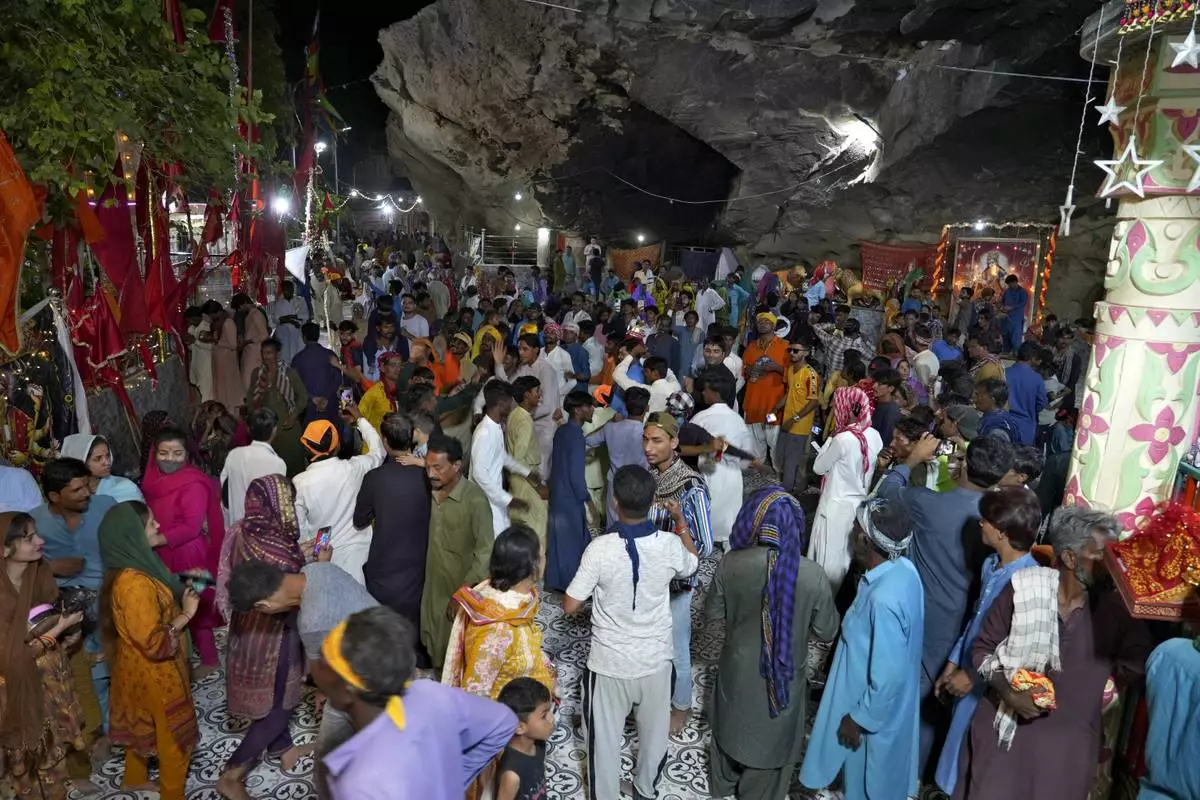
Hindu devotees attend an annual festival in an ancient cave temple of Hinglaj Mata in Hinglaj in Lasbela district in the Pakistan's southwestern Baluchistan province, Friday, April 26, 2024. More than 100,000 Hindus are expected to climb mud volcanoes and steep rocks in southwestern Pakistan as part of a three-day pilgrimage to one of the faith's holiest sites. (AP Photo/Junaid Ahmed)
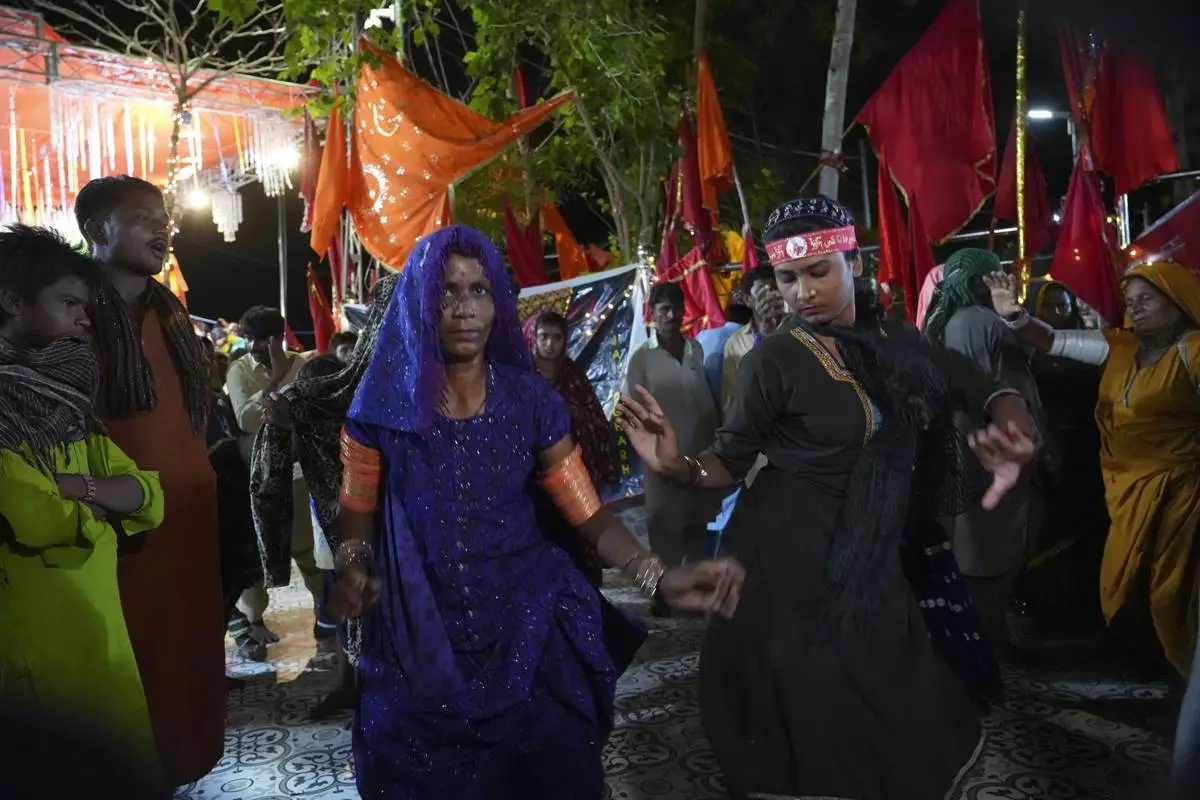
Hindu devotees dance during an annual festival in an cave temple of Hinglaj Mata in Hinglaj in Lasbela district in Pakistan's southwestern Baluchistan province, Friday, April 26, 2024. More than 100,000 Hindus are expected to climb mud volcanoes and steep rocks in southwestern Pakistan as part of a three-day pilgrimage to one of the faith's holiest sites. (AP Photo/Junaid Ahmed)

Hindu devotees perform their rituals during an annual festival in an ancient cave temple of Hinglaj Mata in Hinglaj in Lasbela district in Pakistan's southwestern Baluchistan province, Friday, April 26, 2024. More than 100,000 Hindus are expected to climb mud volcanoes and steep rocks in southwestern Pakistan as part of a three-day pilgrimage to one of the faith's holiest sites. (AP Photo/Junaid Ahmed)
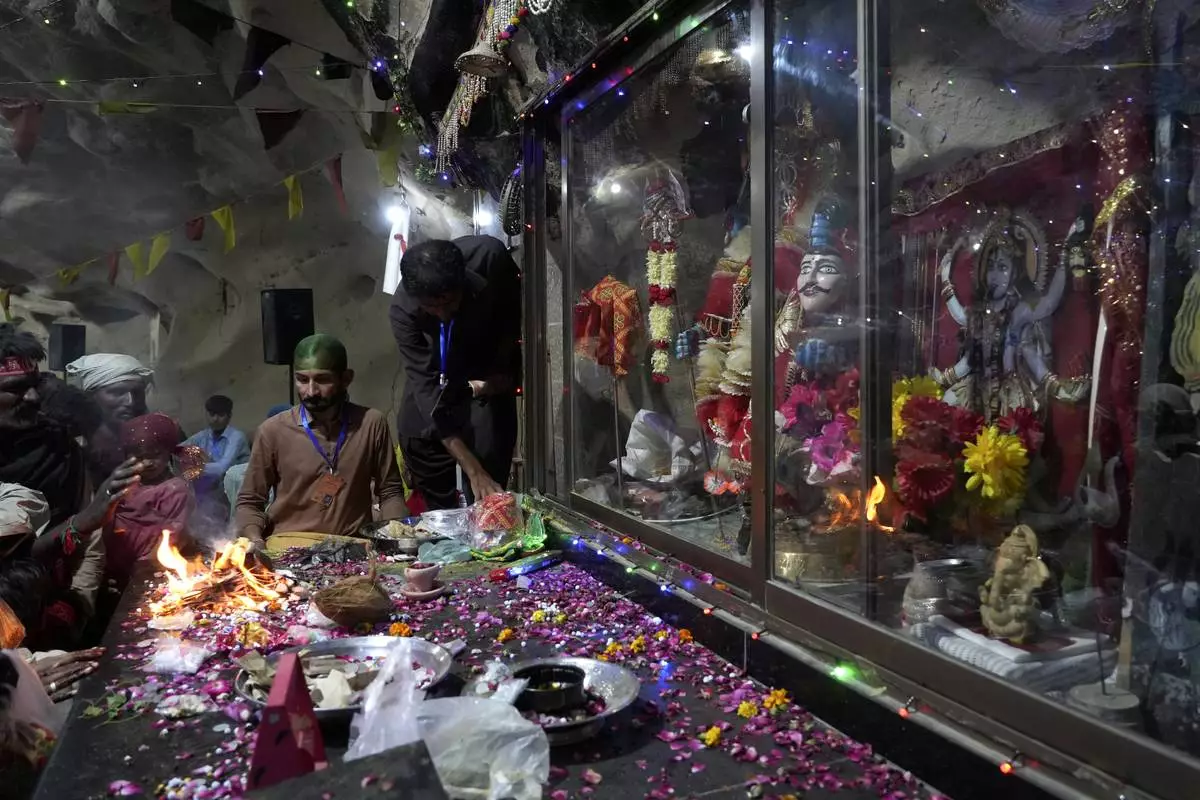
Hindu devotees perform their rituals during an annual festival in an ancient cave temple of Hinglaj Mata in Hinglaj in Lasbela district in Pakistan's southwestern Baluchistan province, Friday, April 26, 2024. More than 100,000 Hindus are expected to climb mud volcanoes and steep rocks in southwestern Pakistan as part of a three-day pilgrimage to one of the faith's holiest sites. (AP Photo/Junaid Ahmed)
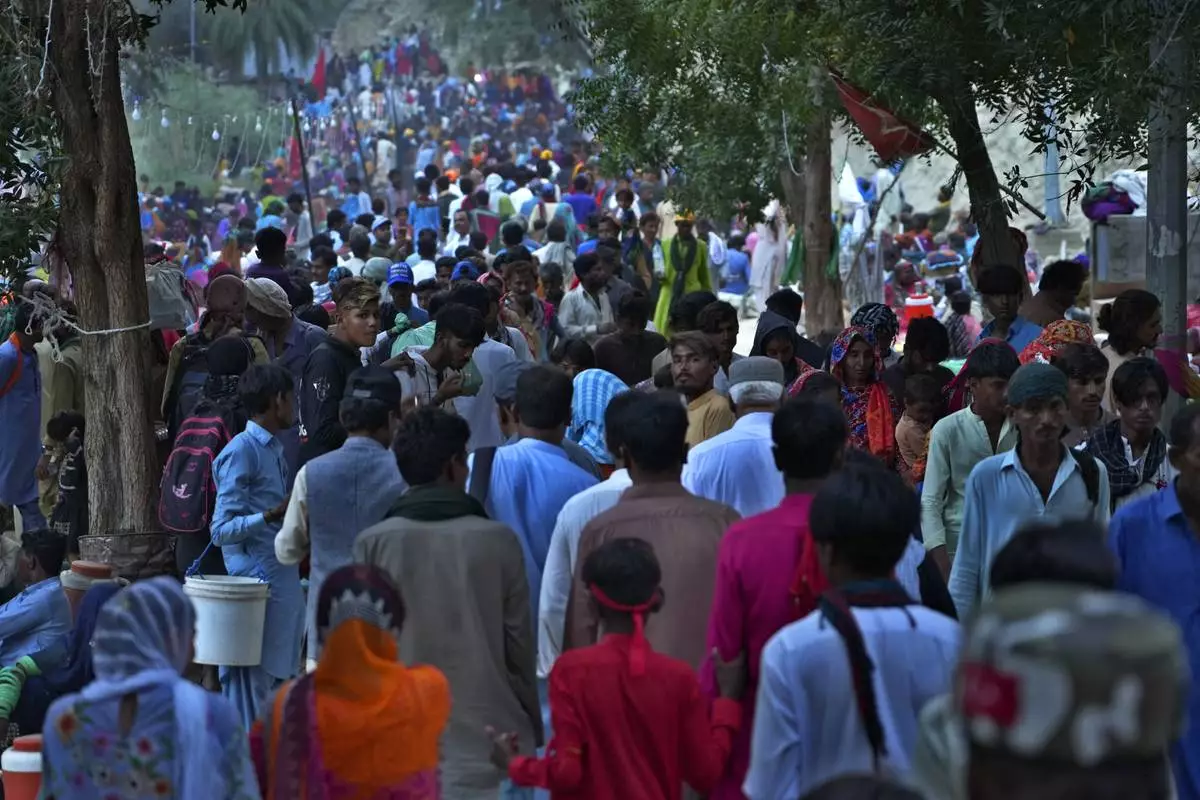
Hindu devotees arrive at an ancient cave temple of Hinglaj Mata to attend an annual festival in Hinglaj in Lasbela district in Pakistan's southwestern Baluchistan province, Friday, April 26, 2024. More than 100,000 Hindus are expected to climb mud volcanoes and steep rocks in southwestern Pakistan as part of a three-day pilgrimage to one of the faith's holiest sites. (AP Photo/Junaid Ahmed)
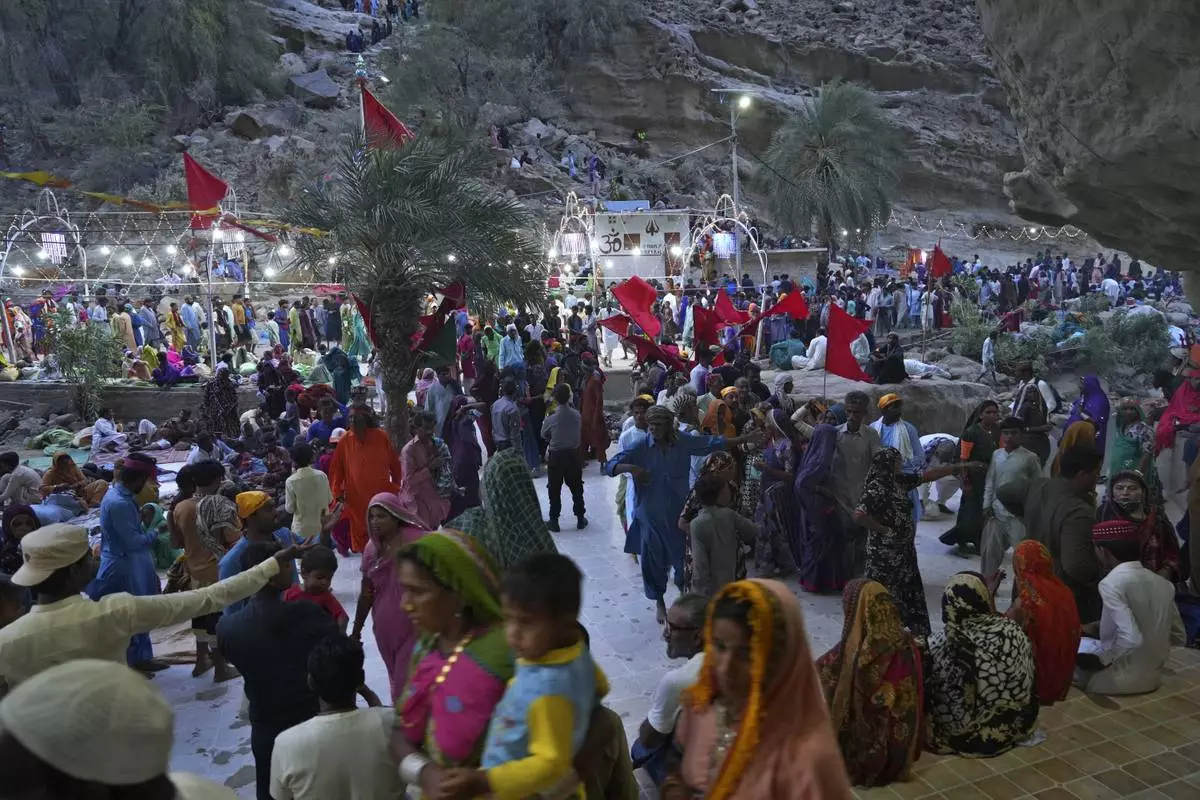
Hindu devotees arrive at an ancient cave temple of Hinglaj Mata to attend an annual festival in Hinglaj in Lasbela district in Pakistan's southwestern Baluchistan province, Friday, April 26, 2024. More than 100,000 Hindus are expected to climb mud volcanoes and steep rocks in southwestern Pakistan as part of a three-day pilgrimage to one of the faith's holiest sites. (AP Photo/Junaid Ahmed)
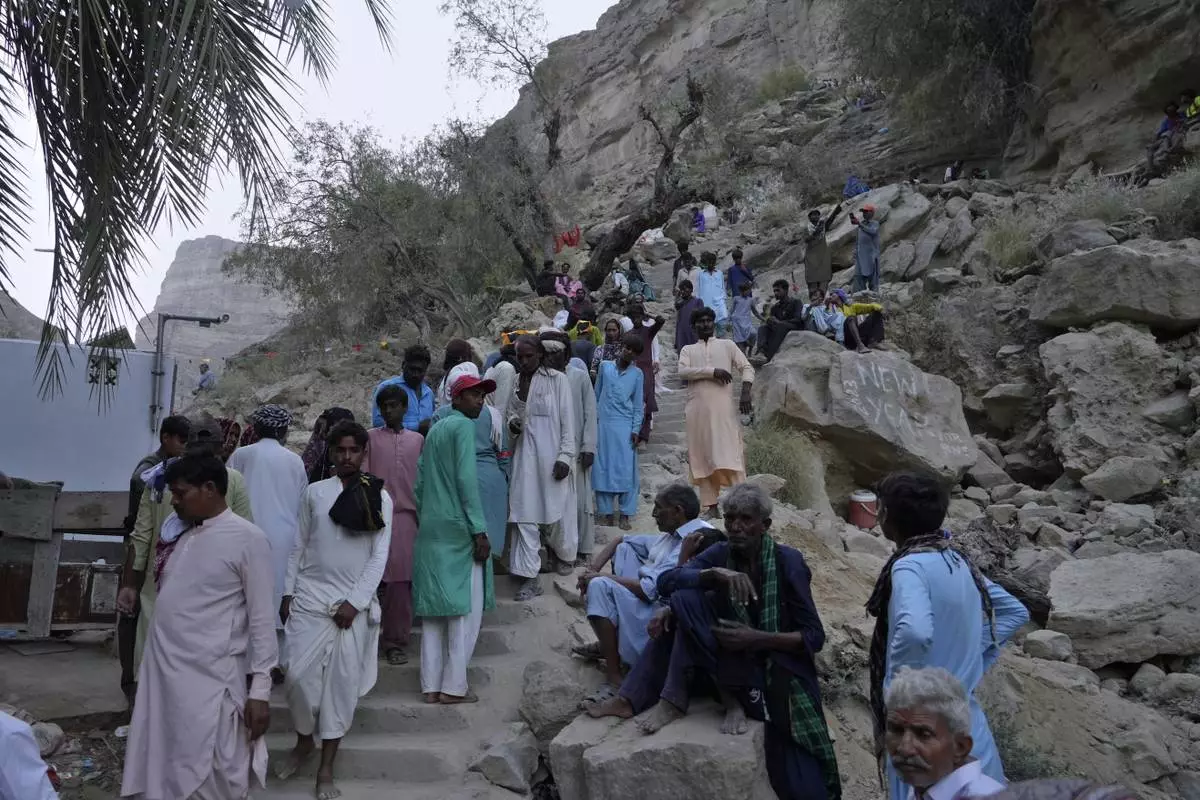
Hindu devotees climb stairs to reach atop an ancient cave temple of Hinglaj Mata to attend an annual festival in Hinglaj in Lasbela district in the Pakistan's southwestern Baluchistan province, Friday, April 26, 2024. More than 100,000 Hindus are expected to climb mud volcanoes and steep rocks in southwestern Pakistan as part of a three-day pilgrimage to one of the faith's holiest sites. (AP Photo/Junaid Ahmed)
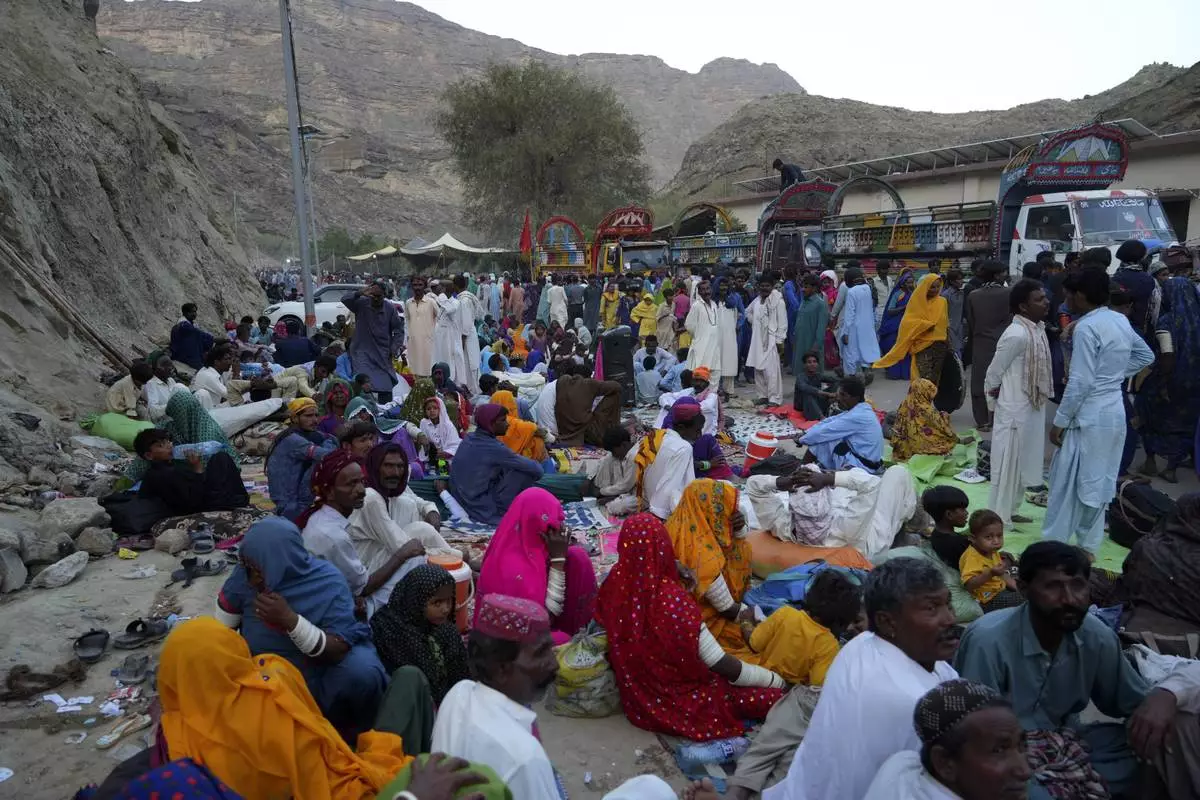
Hindu devotees take rest upon arrival at an ancient cave temple of Hinglaj Mata to attend an annual festival in Hinglaj in Lasbela district in the Pakistan's southwestern Baluchistan province, Friday, April 26, 2024. More than 100,000 Hindus are expected to climb mud volcanoes and steep rocks in southwestern Pakistan as part of a three-day pilgrimage to one of the faith's holiest sites. (AP Photo/Junaid Ahmed)
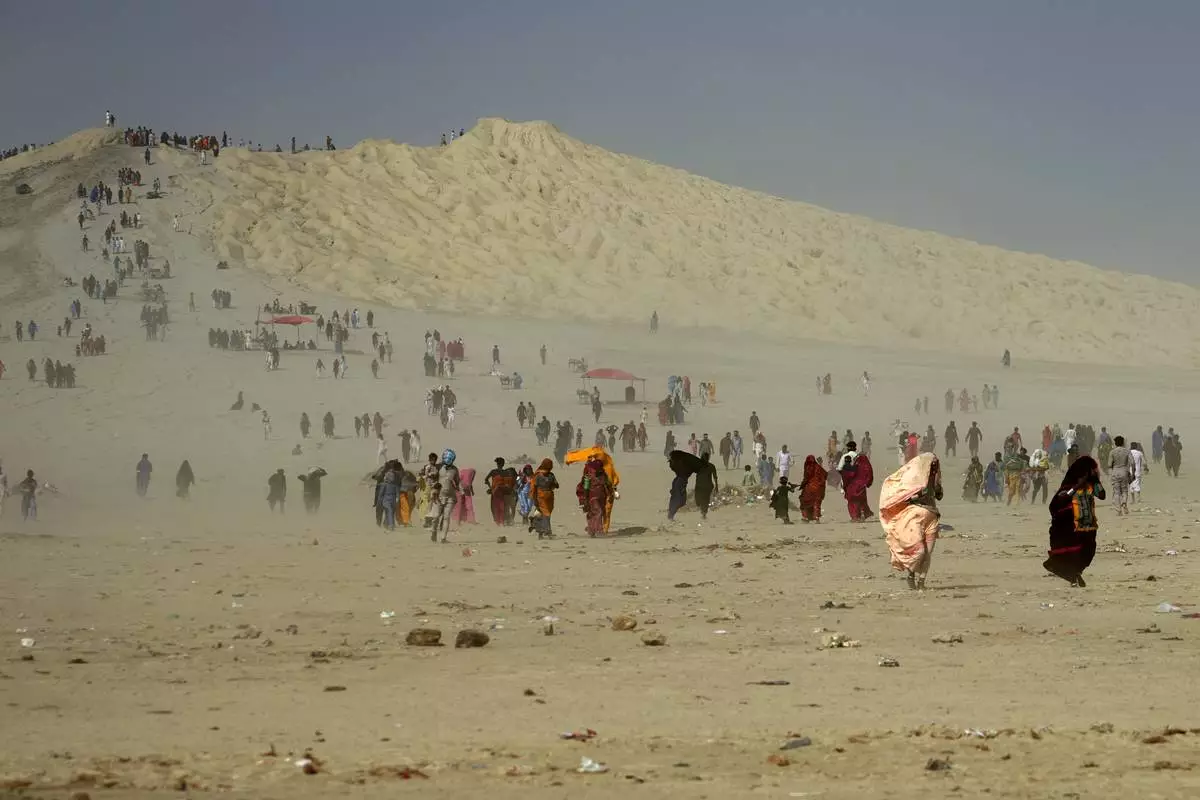
Hindu devotees walk toward a mud volcano, to start Hindu pilgrims' religious rituals for an annual festival in an ancient cave temple of Hinglaj Mata in Hinglaj in Lasbela district in the Pakistan's southwestern Baluchistan province, Friday, April 26, 2024. More than 100,000 Hindus are expected to climb mud volcanoes and steep rocks in southwestern Pakistan as part of a three-day pilgrimage to one of the faith's holiest sites. (AP Photo/Junaid Ahmed)
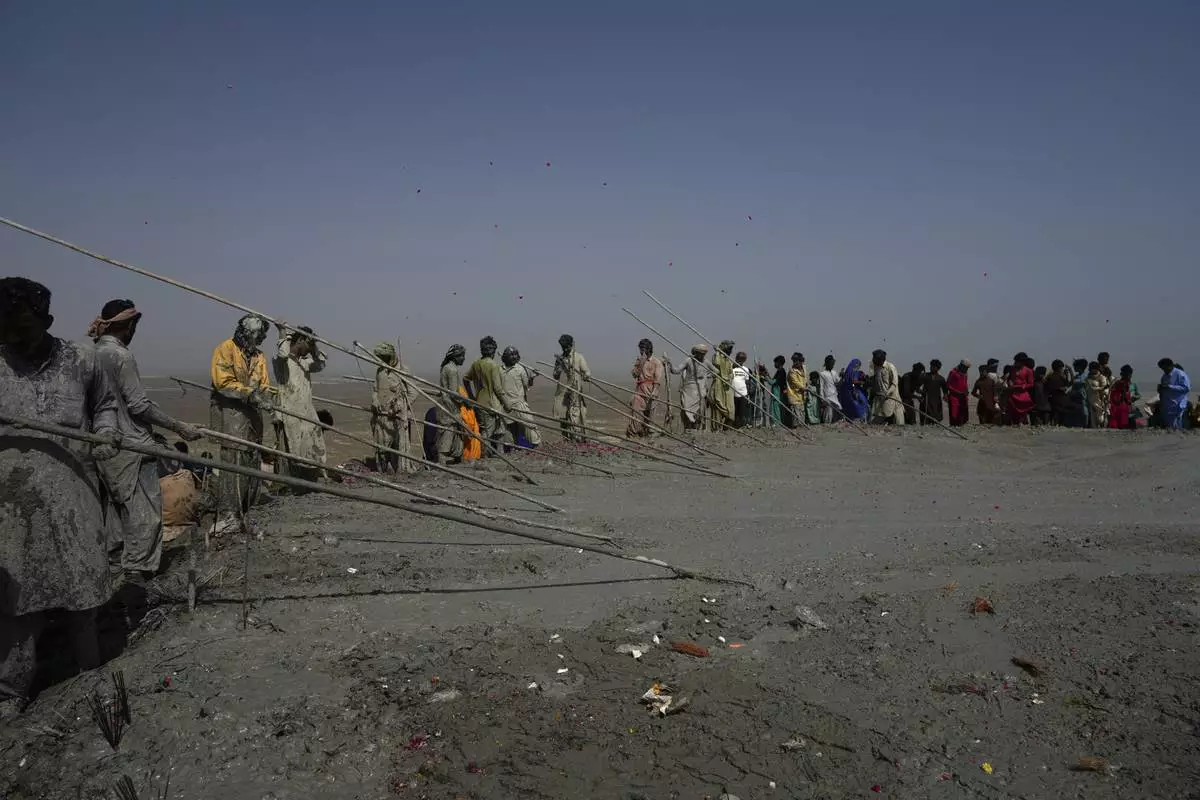
Hindu devotees perform their rituals on a mud volcano to start Hindu pilgrims' religious rituals for an annual festival in an ancient cave temple of Hinglaj Mata in Hinglaj in Lasbela district in the Pakistan's southwestern Baluchistan province, Friday, April 26, 2024. More than 100,000 Hindus are expected to climb mud volcanoes and steep rocks in southwestern Pakistan as part of a three-day pilgrimage to one of the faith's holiest sites. (AP Photo/Junaid Ahmed)
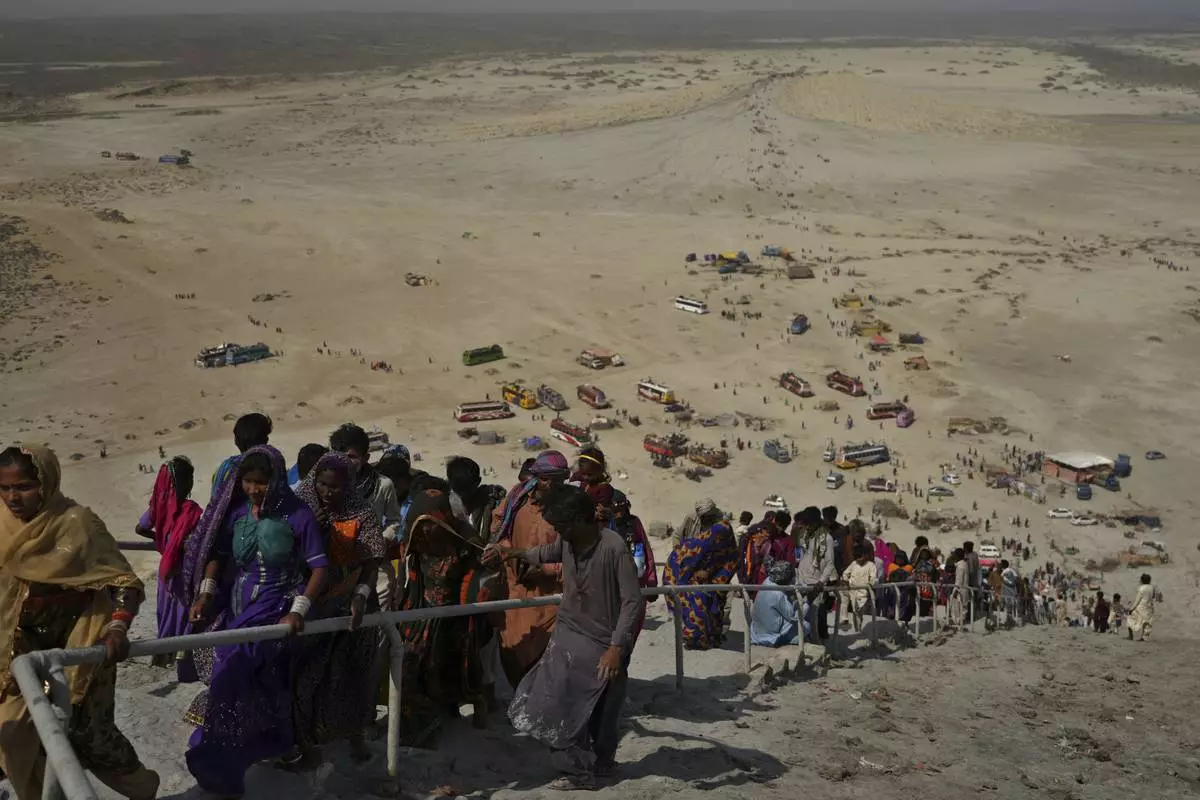
Hindu devotees climb stairs to reach atop a volcano to start Hindu pilgrims' religious rituals for an annual festival in an ancient cave temple of Hinglaj Mata in Hinglaj in Lasbela district in Pakistan's southwestern Baluchistan province, Friday, April 26, 2024. More than 100,000 Hindus are expected to climb mud volcanoes and steep rocks in southwestern Pakistan as part of a three-day pilgrimage to one of the faith's holiest sites. (AP Photo/Junaid Ahmed)
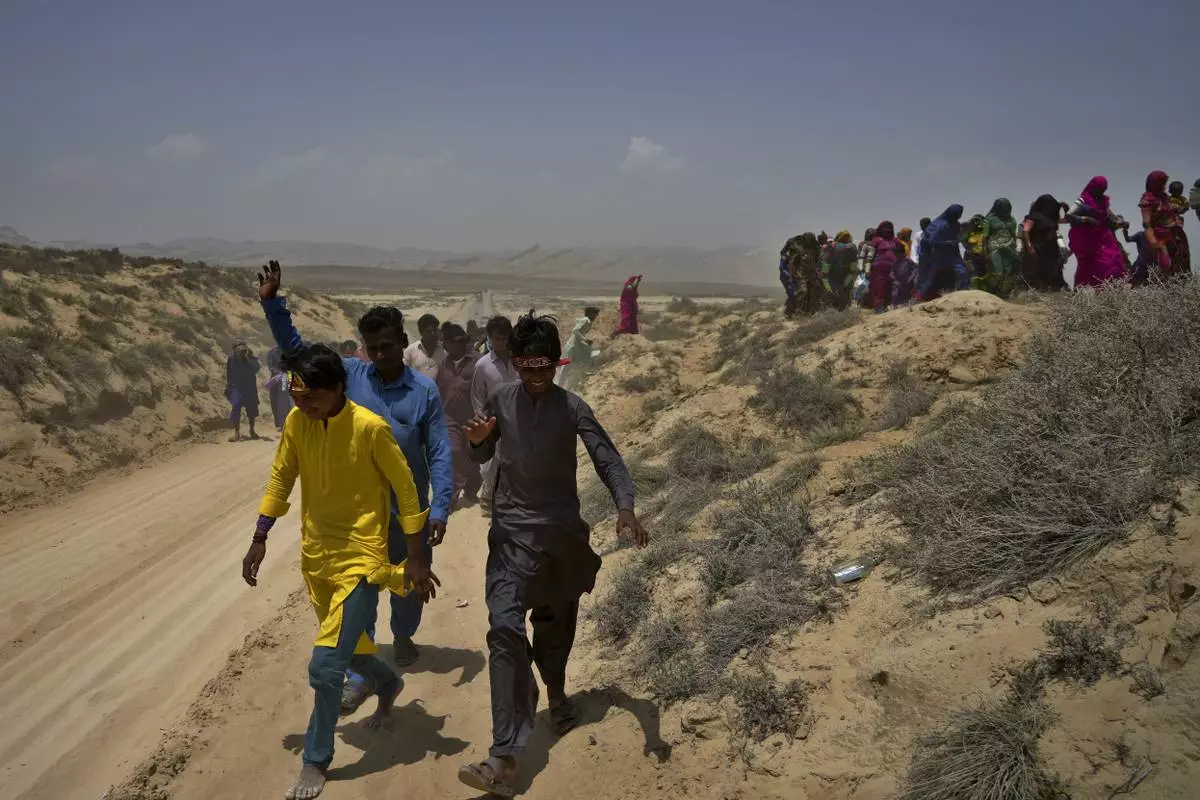
Hindu devotees walk toward a mud volcano to start Hindu pilgrims' religious rituals for an annual festival in an ancient cave temple of Hinglaj Mata in Hinglaj in Lasbela district in the Pakistan's southwestern Baluchistan province, Friday, April 26, 2024. More than 100,000 Hindus are expected to climb mud volcanoes and steep rocks in southwestern Pakistan as part of a three-day pilgrimage to one of the faith's holiest sites. (AP Photo/Junaid Ahmed)

Hindu devotees walk toward a mud volcano to start Hindu pilgrims' religious rituals for an annual festival in an ancient cave temple of Hinglaj Mata in Hinglaj in Lasbela district in the Pakistan's southwestern Baluchistan province, Friday, April 26, 2024. More than 100,000 Hindus are expected to climb mud volcanoes and steep rocks in southwestern Pakistan as part of a three-day pilgrimage to one of the faith's holiest sites. (AP Photo/Junaid Ahmed)
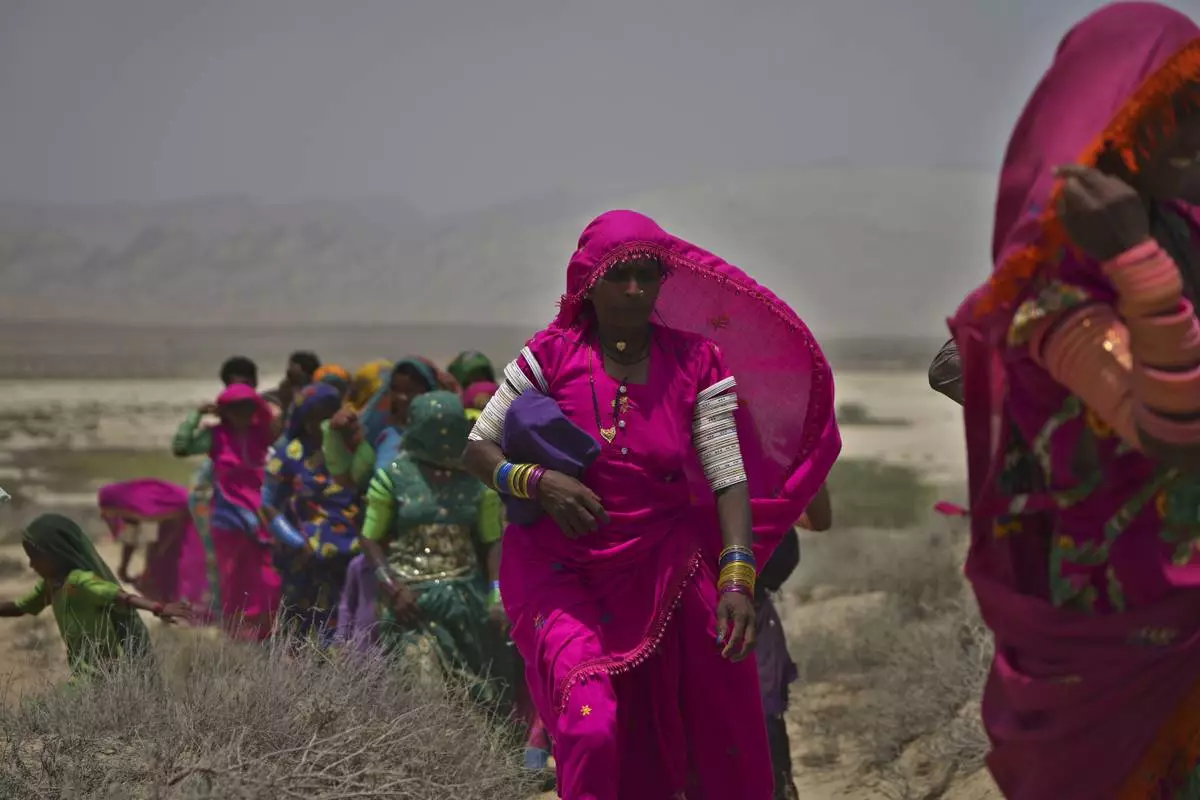
Hindu devotees walk toward a mud volcano to start Hindu pilgrims' religious rituals for an annual festival in an ancient cave temple of Hinglaj Mata in Hinglaj in Lasbela district in the Pakistan's southwestern Baluchistan province, Friday, April 26, 2024. More than 100,000 Hindus are expected to climb mud volcanoes and steep rocks in southwestern Pakistan as part of a three-day pilgrimage to one of the faith's holiest sites. (AP Photo/Junaid Ahmed)
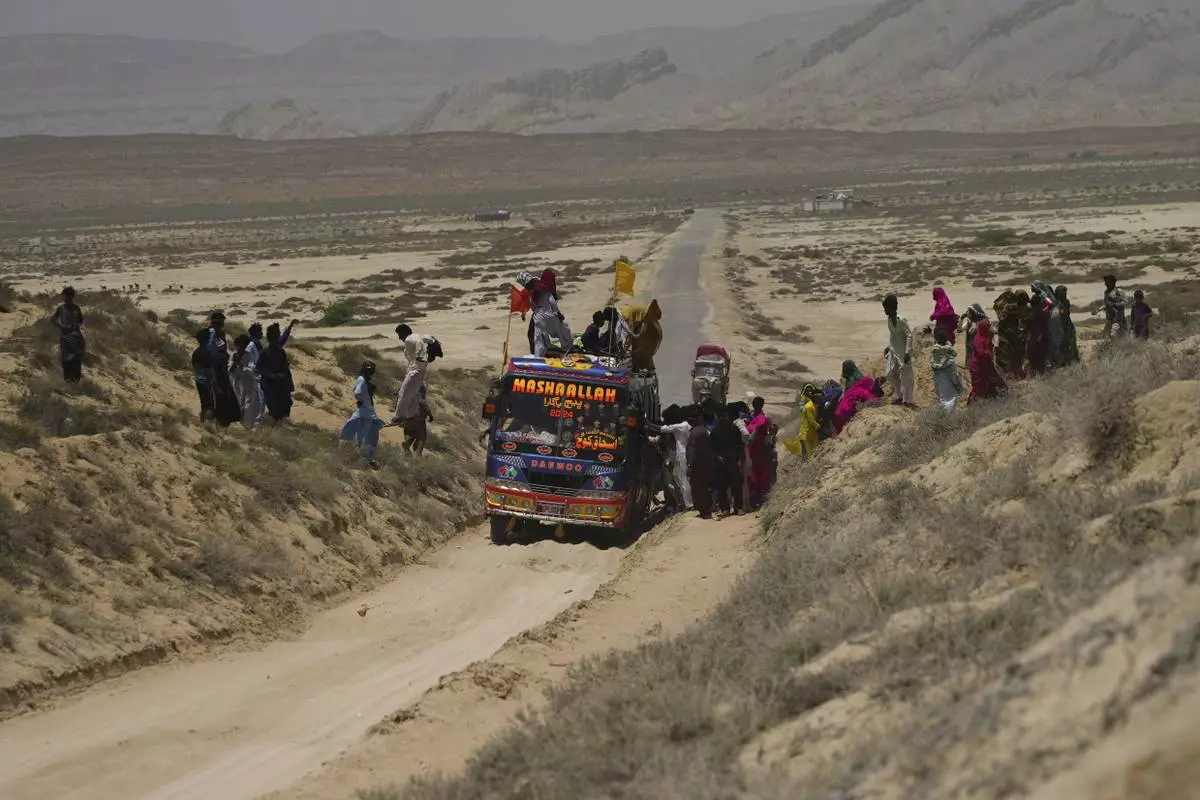
Hindu devotees get off from a bus and walk toward a mud volcano, to start Hindu pilgrims religious rituals for an annual festival in an ancient cave temple of Hinglaj Mata in Hinglaj in Lasbela district in the Pakistan's southwestern Baluchistan province, Friday, April 26, 2024. More than 100,000 Hindus are expected to climb mud volcanoes and steep rocks in southwestern Pakistan as part of a three-day pilgrimage to one of the faith's holiest sites. (AP Photo/Junaid Ahmed)
As cars and trucks get smarter and more connected, the humble lights that have controlled the flow of traffic for more than a century could also be on the cusp of a major transformation.
Researchers are exploring ways to use features in modern cars, such as GPS, to make traffic safer and more efficient. Eventually, the upgrades could do away entirely with the red, yellow and green lights of today, ceding control to driverless cars.
Henry Liu, a civil engineering professor who is leading a study through the University of Michigan, said the rollout of a new traffic signal system could be a lot closer than people realize.
“The pace of artificial intelligence progress is very fast, and I think it’s coming,” he said.
Traffic lights haven’t changed much in the U.S. over the years. Cleveland debuted what is considered the first “municipal traffic control system” in 1914, historian Megan Kate Nelson wrote for Smithsonian Magazine. Powered by the electricity from the city’s trolley line, engineer James Hodge’s invention featured two lights: red and green, the colors long used by railroads. A police officer sitting in a booth on the sidewalk had to flip a switch to change the signal.
A few years later, Detroit police officer William Potts is credited with adding the yellow light, though as a city employee he couldn’t patent it. By 1930, Nelson wrote, all major American cities and many smaller ones had at least one electrical traffic signal.
The advent of connected and automated vehicles, though, has presented a world of new possibilities for traffic signals.
Among those reimagining traffic flows is a team at North Carolina State University led by Ali Hajbabaie, an associate engineering professor. Rather than doing away with today's traffic signals, Hajbabaie suggests adding a fourth light, perhaps a white one, to indicate when there are enough autonomous vehicles on the road to take charge and lead the way.
“When we get to the intersection, we stop if it's red and we go if it's green," said Hajbabaie, whose team used model cars small enough to hold. “But if the white light is active, you just follow the vehicle in front of you.”
Although Hajbabaie's research refers to a “white phase” and possibly even a white light, the specific color isn’t important, he said. Current lights could even suffice, say, by modifying them to flash red and green simultaneously to signal that driverless cars are in charge. The key would be making sure that it's universally adopted like the current signals are.
Using such an approach would be years away, as it would require 40% to 50% of vehicles on the road to be self-driving in order to work, Hajbabaie acknowledged.
Waymo spokesperson Sandy Karp pointed out that the self-driving car subsidiary of Google's parent company launched a fully autonomous ride-sharing service in Los Angeles and Austin, Texas, even without the addition of a fourth traffic light.
“While it is good at this early stage of AV development that people are thinking creatively about how to facilitate the safe deployment of safe AVs, policymakers and infrastructure owners should be careful about jumping too soon on AV-specific investments that may turn out to be premature or even unnecessary,” Karp said in an email to The Associated Press.
University of Michigan researchers have taken a different approach. They conducted a pilot program in the Detroit suburb of Birmingham using insights from the speed and location data found in General Motors vehicles to alter the timing of that city’s traffic lights. The researchers recently landed a U.S. Department of Transportation grant under the bipartisan infrastructure law to test how to make the changes in real time.
Because the Michigan research deals with vehicles that have drivers, not fully autonomous ones, it could be much closer to wider implementation than what Hajbabaie is seeking.
Liu, who has been leading the Michigan research, said even with as little as 6% of the vehicles on Birmingham’s streets connected to the GM system, they provide enough data to adjust the timing of the traffic lights to smooth the flow.
The 34 traffic signals in Birmingham were chosen because, like more than half of the signals nationwide, they’re set to a fixed-time schedule without any cameras or sensors to monitor congestion. Liu said although there are higher-tech solutions to monitoring traffic, they require cities to make complex and expensive upgrades.
“The beauty of this is you don’t have to do anything to the infrastructure,” Liu said. “The data is not coming from the infrastructure. It’s coming from the car companies.”
Danielle Deneau, director of traffic safety at the Road Commission in Oakland County, Michigan, said the initial data in Birmingham only adjusted the timing of green lights by a few seconds, but it was still enough to reduce congestion. Even bigger changes could be in store under the new grant-funded research, which would automate the traffic lights in a yet-to-be announced location in the county.

This undated photo provided by the University of Michigan College of Engineering shows Jim Lollar, Mcity test facility manager, as he works inside of a traffic control cabinet at the Mcity Test Facility, identical to ones found at signalized intersections across the country. Smarter vehicles could mean some of the most dramatic changes for the traditional traffic signal since the yellow light was added more than a century ago. (Jeremy Little/University of Michigan College of Engineering via AP)

This undated photo provided by University of Michigan College of Engineering shows Dr. Xingmin Wang, postdoctoral research fellow at the University of Michigan-Ann Arbor, showing off a visualization of connected vehicle trajectory data insights which aid in the optimization of traffic signals. Smarter vehicles could mean some of the most dramatic changes for the traditional traffic signal since the yellow light was added more than a century ago. (Jeremy Little/University of Michigan College of Engineering via AP)

This undated photo provided by the University of Michigan College of Engineering shows vehicles as they drive through the Old Woodward Avenue and East Maple signalized intersection, which was retimed using the Optimized Signal as a Service (OSaaS), in Birmingham, Mich. Smarter vehicles could mean some of the most dramatic changes for the traditional traffic signal since the yellow light was added more than a century ago. (Jeremy Little/University of Michigan College of Engineering via AP)




















